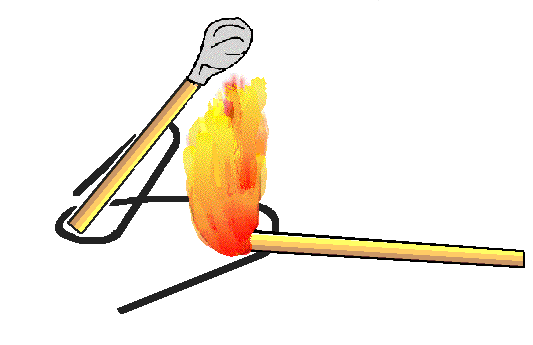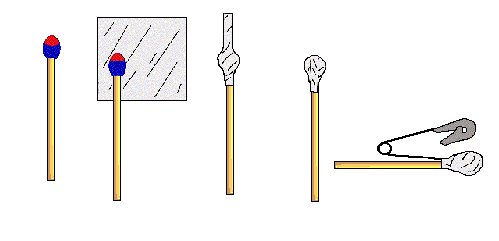| Match Stick Rocket
SUBJECT: Rocketry
TOPIC:
Propulsion
DESCRIPTION:
A small solid propellant rocket is made from a match and a piece of aluminum
foil.
CONTRIBUTED BY:
Steve Culivan, KSC
EDITED BY:
Roger Storm, NASA Glenn Research Center
MATERIALS:
- 2 match book matches
or wooden stick matches
- Small square of
aluminum foil
- Paper clip
- Safety pin
PROCEDURE:
- Take one
match and wrap a small piece of aluminum foil around the match-head.
Wrap the foil tightly.
- Make a small
opening in the foil wrapped around the match head by inserting
the point of a safety pin and bending upward slightly.
- Bend the
paper clip to form a launch pad as shown in the diagrams. Erect
the match stick rocket on the pad. Make sure the pad is set up
on a surface that will not be damaged by the rocket's exhaust
such as a lab table. Several layers of foil on the lab table work
well.
- Ignite the
match by holding a second lighted match under the foil until its
combustion temperature is reached.
Caution:
Be sure the match rocket is pointed away from people or burnable materials.
it is recommended to have water or some other fire extinguishant available.
The foil head of the rocket will be very hot!

DISCUSSION:
The match stick rocket demonstrates Isaac Newton's Laws of Motion as they
relate to rocketry. Newton's third law states that for every action, there
is an opposite and equal reaction. The exhaust of the fire products from
the burning match (smoke and gas) is the "action" and the movement of
the rocket in the other direction is the 'reaction.' The action thrust
is produced when the match burns in an enclosed environment. The aluminum
foil acts as a rocket combustion chamber. Because the opening in the foil
is small, pressure builds up in the chamber that eventually escapes as
a rapid stream of smoke and gas.
In an interesting
variation of the experiment, try making holes of different diameters to
let the combustion products out at different rates. A larger opening permits
the smoke and gas to escape before it has time to build up much pressure.
The escape of the products will be slower than produced by a match stick
rocket with a smaller opening. Isaac Newton's second law states that the
force or thrust of a rocket is equal to the mass of the smoke and gas
escaping the rocket times how fast it escapes. In this experiment, the
mass of the smoke and gas is the same for both cases. The difference is
in how fast it escapes. Compare the distance traveled with the two match
stick rockets.
| 